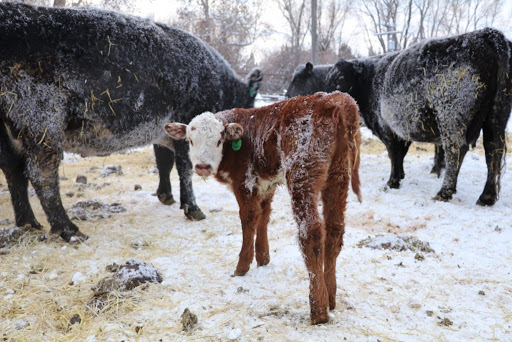
Senior Farm and Ranch Broadcaster, Ron Hays, is featuring comments from Oklahoma State University Extension Veterinary Specialist, Dr. Rosslyn Biggs, talking about taking care of cattle during the cold weather.
“Now is the time to really start those preparations for that cold weather,” Biggs said.
Although many areas received some rainfall last week and this week, Biggs said the state is still in a drought situation, so many are short on forage and hay.
“We need to be having preparations ready to go for those animals and particularly thinking about those that are spending the majority of their time outside,” Biggs said. “Making sure we have got hay and feed ready to go. Don’t forget water- that is a big one.”
Regarding the amount of roughage needed to get through the winter, Biggs said it is highly variable depending on the size of the cow.
“We want to keep those protein and energy thresholds ready to go for those animals and keep them running in the cold,” Biggs said.
Healthwise, Biggs said it is critical to keep an eye on the young and the old cattle that may be slightly compromised. When it comes time to calve out, Biggs said there should be plans in place to manage those calves in particular, because they are not able to thermoregulate.
“They need to get dry, and they need to get dry quick, and they need to get that colostrum in them so they can really thrive in these conditions,” Biggs said.
The Cattle Comfort Index, Biggs said is a great resource to reference for producers trying to figure out in what circumstances they may need to put more effort into factors such as shelter.
“The shelter component of it becomes really important in my mind for those that are not able to move comfortably,” Biggs said. “We are thinking about, again, young and old or immunocompromised. We may want to separate those groups out and those that are not going to be able to access that hay and feed as readily as others.”
The temperature extremes often seen in Oklahoma, Biggs said, can be withstood by livestock as long as they are fed well enough. As cattle start to congregate around hay supplies or sheltered areas in the winter, Biggs said there is more potential for respiratory illness to transfer from one group to another.
“We do want to think about those biosecurity measures, particularly if we are bringing new individuals onto the operation, or if your neighbors are rotating cattle through, that we can see those,” Biggs said.
The Beef Buzz is a regular feature heard on radio stations around the region on the Radio Oklahoma Ag Network and is a regular audio feature found on this website as well. Click on the LISTEN BAR for today’s show and check out our archives for older Beef Buzz shows covering the gamut of the beef cattle industry today.















